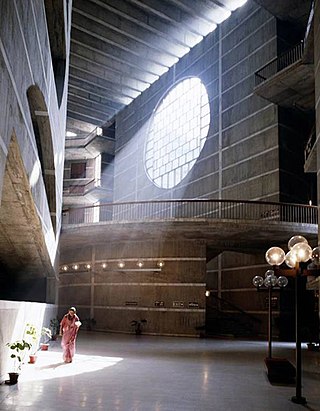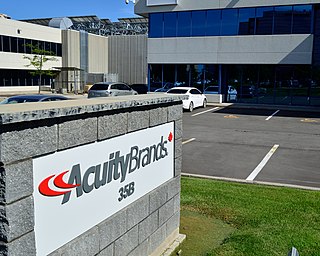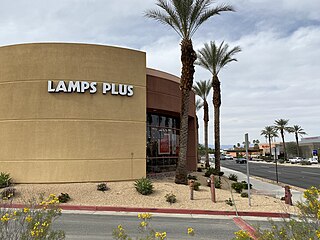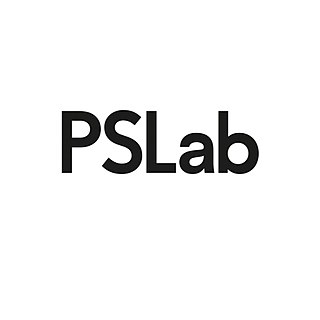
Stage lighting is the craft of lighting as it applies to the production of theater, dance, opera, and other performance arts. Several different types of stage lighting instruments are used in this discipline. In addition to basic lighting, modern stage lighting can also include special effects, such as lasers and fog machines. People who work on stage lighting are commonly referred to as lighting technicians or lighting designers.

Lighting or illumination is the deliberate use of light to achieve practical or aesthetic effects. Lighting includes the use of both artificial light sources like lamps and light fixtures, as well as natural illumination by capturing daylight. Daylighting is sometimes used as the main source of light during daytime in buildings. This can save energy in place of using artificial lighting, which represents a major component of energy consumption in buildings. Proper lighting can enhance task performance, improve the appearance of an area, or have positive psychological effects on occupants.

A chandelier is a branched ornamental light fixture designed to be mounted on ceilings or walls. Chandeliers are often ornate, and normally use incandescent light bulbs, though some modern designs also use fluorescent lamps and recently LEDs.

A compact fluorescent lamp (CFL), also called compact fluorescent light, energy-saving light and compact fluorescent tube, is a fluorescent lamp designed to replace an incandescent light bulb; some types fit into light fixtures designed for incandescent bulbs. The lamps use a tube that is curved or folded to fit into the space of an incandescent bulb, and a compact electronic ballast in the base of the lamp.

Architectural lighting design is a field of work or study that is concerned with the design of lighting systems within the built environment, both interior and exterior. It can include manipulation and design of both daylight and electric light or both, to serve human needs.

A light fixture, light fitting, lamp, or luminaire is an electrical device containing an electrical component called a lamp that provides illumination. All light fixtures have a fixture body and one or more lamps. The lamps may be in sockets for easy replacement—or, in the case of some LED fixtures, hard-wired in place.

Cove lighting is a form of indirect lighting built into ledges, recesses, or valances in a ceiling or high on the walls of a room. It directs light up towards the ceiling and down adjacent walls. It may be used as primary lighting, or for aesthetic accent, especially to highlight decorative ceilings. Cove lighting is valued because it hides the fixtures, and because it provides a very even light.
The Genlyte Group was a company that manufactured and sold lighting fixtures and controls. Products designed by the Genlyte Group include indoor and outdoor fixtures for the commercial, residential, theater, and industrial markets. Genlyte was bought out by Royal Philips Lighting on January 18, 2008.

A multifaceted reflector light bulb is a reflector housing format for halogen as well as some LED and fluorescent lamps. MR lamps were originally designed for use in slide projectors, but see use in residential lighting and retail lighting as well. They are suited to applications that require directional lighting such as track lighting, recessed ceiling lights, desk lamps, pendant fixtures, landscape lighting, retail display lighting, and bicycle headlights. MR lamps are designated by symbols such as MR16 where the diameter is represented by numerals indicating units of eighths of an inch. Common sizes for general lighting are MR16 and MR11, with MR20 and MR8 used in specialty applications. Many run on low voltage rather than mains voltage alternating current so require a power supply.

Track lighting is a method of lighting where light fixtures are attached anywhere on a continuous track device which contains electrical conductors. This is in contrast to directly routing electrical wiring to individual light positions. Tracks can either be mounted to ceilings or walls, lengthwise down beams, or crosswise across rafters or joists. They can also be hung with rods from especially high places like vaulted ceilings.

Acuity Brands, Inc. is a lighting and building management firm headquartered in Atlanta, Georgia, with operations throughout North America and in Europe and Asia. It currently has about 13,000 employees and recorded net sales of $3.7 billion for fiscal year 2018. In terms of market share, Acuity Brands is the largest lighting manufacturer in North America.

Lamps Plus, Inc. is a privately held corporation that designs, manufactures, and sells portable lighting, fixture lighting, furniture, home décor items and a variety of other related products. Its worldwide headquarters is located in the Chatsworth district of the San Fernando Valley region of the city of Los Angeles, California.

Ronald John Rezek is a design entrepreneur who started five successful companies and has designed hundreds of contemporary light fixtures and ceiling fans. He is an expert on design patents and copyrights, and is often used as an expert witness in court.
Edward F. Caldwell & Co., of New York City, was one of the premier designers and manufacturers of electric light fixtures and decorative metalwork from the late 19th to the mid-20th centuries. Founded in 1895 by Edward F. Caldwell (1851–1914) and Victor F. von Lossberg (1853–1942), the firm left a legacy of custom designed and finely-made, metal gates, lanterns, chandeliers, ceiling and wall fixtures, floor and table lamps, and other decorative objects that can be found today in many metropolitan area churches, public buildings, offices, clubs, and residences including, the White House, St. Patrick's Cathedral, New York, New York Public Library, and Rockefeller Center.

Henry Northey Hooper was a preeminent 19th-century American manufacturer and merchant of decorative lighting, Civil War artillery, and bells and chimes. He was a Boston politician and foundry owner and in his firm he cast the first life-size bronze statue in the United States.

A recessed light or downlight is a light fixture that is installed into a hollow opening in a ceiling. When installed it appears to have light shining from a hole in the ceiling, concentrating the light in a downward direction as a broad floodlight or narrow spotlight.
LED chandeliers are either normal chandeliers that have been retrofitted with LED bulbs, or contemporary designs that use light emitting diodes and acrylic or crystals.

PSLab is a lighting design company based in Beirut, Lebanon and has offices in several other countries. They design and build lighting fixtures for residential, commercial, and community spaces.
Michael Lax (1929–1999) was an American industrial designer who created household products for companies such as Copco, Lightolier, Dansk, Salton, Metaal, Mikasa, Tupperware, and American Cyanamid. Several of his best-known products, including the Lytegem lamp by Lightolier and the Copco enamel-coated teakettle with teak handle, are represented in permanent museum collections.
Angelo Gaetano Sciolari (1927-1994) was the owner of Sciolari Lighting and designer for the Italian manufacturer Stilnovo in the 1950s. It was while working for Stilnovo that Sciolari "created his most recognizable and celebrated designs, a series of multi-light chandeliers fashioned with both glossy and matte metal, conjuring up futuristic visions of the dawning space age." Throughout the 1960s, 70s, and 80s his designs were in demand, with his designs imported to the American market by Lightolier & Progress Lighting. During this same period, his designs appeared prominently in popular television and film due to their luxurious and futuristic appearance. He gave up working in film to pursue architecture.














